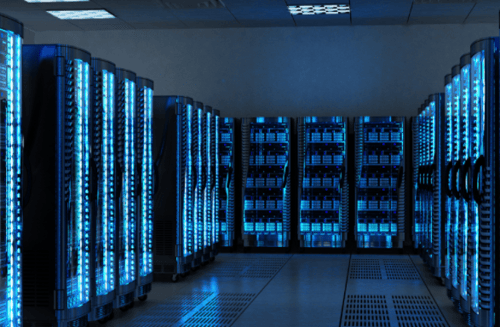Sustainable Data Centers: Energy Efficiency & Emissions Reduction Tips

The state of the modern data center industry is best summed up by a comment from an artificial intelligence (AI) expert in a recent Data Center Frontier white paper: “We are in the wild, wild west right now. There are no rules.”
The publication says that data centers are at a critical juncture in our increasingly digital-first world, becoming larger and requiring more power than ever to meet the seemingly insatiable demands of AI.
“On average, a ChatGPT query needs nearly 10 times as much electricity to process as a Google search. In that difference lies a coming sea change in how the US, Europe, and the world at large will consume power — and how much that will cost,” says Goldman Sachs Research. “For years, data centers displayed a remarkably stable appetite for power, even as their workloads mounted. Now, as the pace of efficiency gains in electricity use slows and the AI revolution gathers steam, Goldman Sachs Research estimates that data center power demand will grow 160 percent by 2030.”
Data Center Wild, Wild West: AI and HPC Workloads
As society’s reliance on technology grows, so do the pitfalls for the data center industry: increased costs, grid instability, regulatory backlash, operational bottlenecks, and maybe most concerning, environmental impact.
“Data centers are getting bigger, denser, and more power-hungry than ever,” says the white paper, pointing out the average capacity per data center building in 2002 rose to 132,000 square feet, with cloud service providers now requiring an average of 205,000 square feet, and mega facilities reaching a mind-boggling 550,000 square feet. “Such mega-facilities have an almost insatiable demand for more power. A surge in demand for AI and high-performance computing (HPC) workloads is accelerating these trends.”
These new power demands come when data centers already consume an estimated 1 to 2 percent of global electricity.
The good news is that data center operators are not just standing pat but are embracing sustainability initiatives.
“They seek to drastically lower their carbon footprints by adopting renewable energy and achieving ever-higher levels of power efficiency,” says the white paper.
Let’s look closer at the best practices for sustainable data center operations, focusing on energy efficiency and emissions reduction.
Energy Efficiency Best Practices
Implementing energy-efficient practices is crucial for reducing the environmental footprint of data centers. Here are some key strategies:
- Optimizing Cooling Systems: Cooling is one of the most energy-intensive aspects of data center operations. Modern solutions include:
- Free cooling: Utilizing outside air to cool data centers when ambient temperatures allow.
- Liquid cooling: Employing liquid-based systems to more efficiently remove heat from servers.
- Hot/cold aisle containment: Separating hot and cold air streams to improve cooling efficiency.
- Implementing Efficient Power Distribution: Minimizing power loss during distribution is essential. This can be achieved through:
- High-efficiency power supplies.
- Advanced power management systems.
- DC power distribution to reduce AC-DC conversion losses.
- Utilizing Renewable Energy Sources: Many data centers are transitioning to renewable energy sources:
- On-site solar or wind power generation.
- Power purchase agreements (PPAs) with renewable energy providers.
- Participation in green energy programs offered by utility companies.
- Employing Energy-Efficient Hardware: Choosing the right hardware can significantly impact energy consumption:
- Energy Star certified equipment.
- High-efficiency servers and storage devices.
- Modular, scalable hardware solutions.
“The solution lies in both a modernization of the power infrastructure and a redoubling of efforts to boost energy efficiency,” concludes the white paper. “Internally, advanced power management systems must become commonplace inside data centers.”
Emissions Reduction Strategies
Beyond energy efficiency, data centers must focus on reducing their overall carbon footprint.
“Data centers are increasingly subject to rules and regulations that require they meet specific emissions, power usage, sustainability, and net-zero targets,” says the white paper.
Here are some emissions reduction strategies:
- Transitioning to Carbon-Neutral or Net-Zero Operations: Many leading tech companies have committed to carbon-neutral or net-zero operations. This involves:
- Comprehensive carbon accounting across all operations.
- Setting science-based targets for emissions reduction.
- Implementing a roadmap to achieve carbon neutrality or net-zero emissions.
- Participating in Carbon Offset Programs: While working towards reducing direct emissions, data centers can offset their remaining carbon footprint by:
- Investing in reforestation projects.
- Supporting renewable energy development in other regions.
- Funding energy efficiency initiatives in underdeveloped areas.
- Implementing Circular Economy Principles: Addressing the e-waste problem is crucial for sustainability:
- Designing hardware for longevity and repairability.
- Establishing robust recycling and refurbishment programs.
- Partnering with specialized e-waste management companies.
- Data Center Infrastructure Management (DCIM): DCIM software plays a crucial role in optimizing data center operations:
- Real-time monitoring of energy consumption and environmental conditions.
- Automated adjustments to cooling and power systems for optimal efficiency.
- Capacity planning and predictive maintenance to avoid overprovisioning.
- Implementing AI and Machine Learning: Advanced AI algorithms can further enhance data center efficiency:
- Predictive models for workload management.
- Intelligent cooling system optimization.
- Anomaly detection for early identification of potential issues.
Green Building Design and Certifications
Sustainability should be a priority from the ground up in data center design.
The Leadership in Energy and Environmental Design (LEED) certification provides a framework for green building design:
- Energy-efficient building envelope.
- Water conservation measures.
- Sustainable site selection and development.
Key considerations in sustainable data center design include:
- Modular, scalable architecture to minimize wasted capacity.
- Use of sustainable and locally sourced building materials.
- Integration with local ecosystems to minimize environmental impact.
Future Trends in Sustainable Data Center Operations
As technology evolves, new opportunities for sustainability emerge including edge computing.
The rise of edge computing could lead to more distributed, smaller data centers:
- Potential for better integration with local renewable energy sources.
- Reduced need for long-distance data transmission, saving energy.
Other innovative solutions that are being developed include:
- Advanced battery storage systems for better renewable energy integration.
- High-temperature superconductors for more efficient power distribution.
- Quantum computing for potential energy savings in certain applications.
Partnering with DCS for a Sustainable Future
Sustainable data center operations are no longer optional but a necessity. By implementing energy efficiency best practices, focusing on emissions reduction, and embracing innovative technologies, data centers can significantly reduce their environmental impact.
DCS takes a consultative approach to designing, manufacturing and installing fiber connectivity solutions. We believe as we move forward as an industry, it’s crucial for data center operators to:
- Continuously assess and improve their environmental performance.
- Invest in research and development of sustainable technologies.
- Collaborate with industry partners to share best practices and drive innovation.
By prioritizing sustainability, the data center industry can continue to support our digital world while minimizing its impact on the physical one.
We are committed to working with our partners to build a sustainable future for all.
Subscribe to News
Recent posts
LATEST NEWS
Monday October 30, 2023
Tuesday April 16, 2024
Friday February 9, 2024







